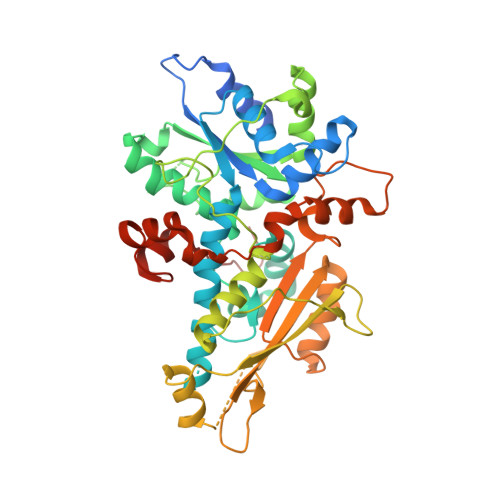Stepwise [FeFe]-hydrogenase H-cluster assembly revealed in the structure of HydA(DeltaEFG).
Mulder, D.W., Boyd, E.S., Sarma, R., Lange, R.K., Endrizzi, J.A., Broderick, J.B., Peters, J.W.(2010) Nature 465: 248-251
- PubMed: 20418861
- DOI: https://doi.org/10.1038/nature08993
- Primary Citation of Related Structures:
3LX4 - PubMed Abstract:
Complex enzymes containing Fe-S clusters are ubiquitous in nature, where they are involved in a number of fundamental processes including carbon dioxide fixation, nitrogen fixation and hydrogen metabolism. Hydrogen metabolism is facilitated by the activity of three evolutionarily and structurally unrelated enzymes: the [NiFe]-hydrogenases, [FeFe]-hydrogenases and [Fe]-hydrogenases (Hmd). The catalytic core of the [FeFe]-hydrogenase (HydA), termed the H-cluster, exists as a [4Fe-4S] subcluster linked by a cysteine thiolate to a modified 2Fe subcluster with unique non-protein ligands. The 2Fe subcluster and non-protein ligands are synthesized by the hydrogenase maturation enzymes HydE, HydF and HydG; however, the mechanism, synthesis and means of insertion of H-cluster components remain unclear. Here we show the structure of HydA(DeltaEFG) (HydA expressed in a genetic background devoid of the active site H-cluster biosynthetic genes hydE, hydF and hydG) revealing the presence of a [4Fe-4S] cluster and an open pocket for the 2Fe subcluster. The structure indicates that H-cluster synthesis occurs in a stepwise manner, first with synthesis and insertion of the [4Fe-4S] subcluster by generalized host-cell machinery and then with synthesis and insertion of the 2Fe subcluster by specialized hydE-, hydF- and hydG-encoded maturation machinery. Insertion of the 2Fe subcluster presumably occurs through a cationically charged channel that collapses following incorporation, as a result of conformational changes in two conserved loop regions. The structure, together with phylogenetic analysis, indicates that HydA emerged within bacteria most likely from a Nar1-like ancestor lacking the 2Fe subcluster, and that this was followed by acquisition in several unicellular eukaryotes.
Organizational Affiliation:
Astrobiology Biogeocatalysis Research Center, Montana State University, Bozeman, Montana 59717, USA.

















